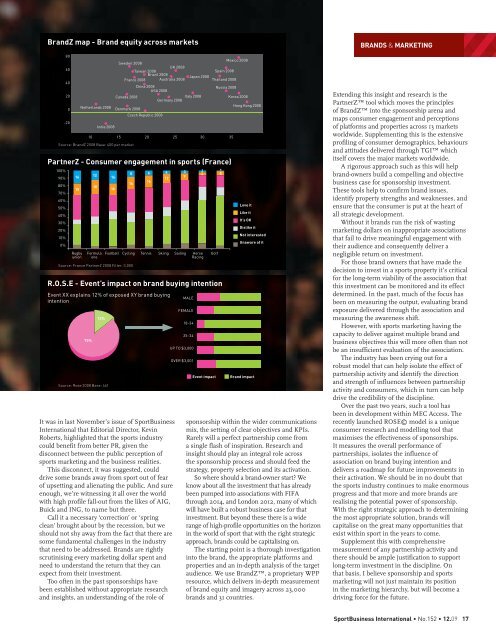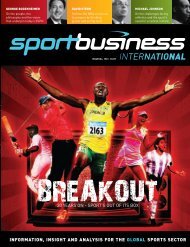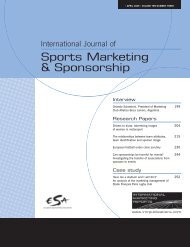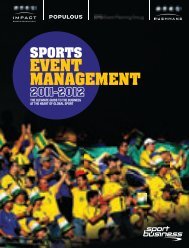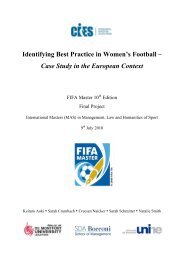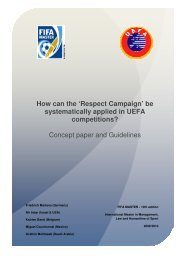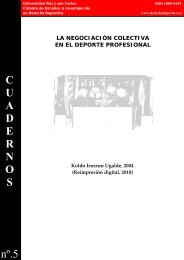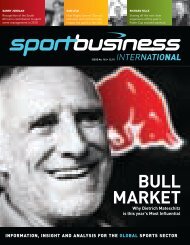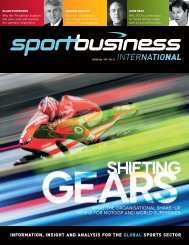01 cover sbi 152.indd - FIFA/CIES International University Network
01 cover sbi 152.indd - FIFA/CIES International University Network
01 cover sbi 152.indd - FIFA/CIES International University Network
Create successful ePaper yourself
Turn your PDF publications into a flip-book with our unique Google optimized e-Paper software.
BrandZ map - Brand equity across markets<br />
80<br />
60<br />
40<br />
20<br />
0<br />
-20<br />
10 15 20 25 30 35<br />
Source: BrandZ 2008 Base: 400 per market<br />
PartnerZ - Consumer engagement in sports (France)<br />
100%<br />
90%<br />
80%<br />
70%<br />
60%<br />
50%<br />
40%<br />
30%<br />
20%<br />
10%<br />
0%<br />
16<br />
15<br />
Mexico 2008<br />
Sweden 2008<br />
UK 2008<br />
Taiwan 2008<br />
Spain 2008<br />
Brazil 2008<br />
Japan 2008<br />
France 2008 Australia 2008<br />
Thailand 2008<br />
China 2008<br />
Russia 2008<br />
USA 2008<br />
Canada 2008<br />
Italy 2008<br />
Korea 2008<br />
Germany 2008<br />
Netherlands 2008 Denmark 2008<br />
Hong Kong 2008<br />
Czech Republic 2008<br />
Rugby Formula Football Cycling Tennis Skiing Sailing Horse Golf<br />
union one Racing<br />
Source: France PartnerZ 2008 Filter: 3,000<br />
R.O.S.E - Event’s impact on brand buying intention<br />
Event XX explains 12% of exposed XY brand buying<br />
intention<br />
75%<br />
12<br />
18<br />
India 2008<br />
12%<br />
Source: Rose 2008 Base: 461<br />
It was in last November’s issue of SportBusiness<br />
<strong>International</strong> that Editorial Director, Kevin<br />
Roberts, highlighted that the sports industry<br />
could benefit from better PR, given the<br />
disconnect between the public perception of<br />
sports marketing and the business realities.<br />
This disconnect, it was suggested, could<br />
drive some brands away from sport out of fear<br />
of upsetting and alienating the public. And sure<br />
enough, we’re witnessing it all over the world<br />
with high profile fall-out from the likes of AIG,<br />
Buick and ING, to name but three.<br />
Call it a necessary ‘correction’ or ‘spring<br />
clean’ brought about by the recession, but we<br />
should not shy away from the fact that there are<br />
some fundamental challenges in the industry<br />
that need to be addressed. Brands are rightly<br />
scrutinising every marketing dollar spent and<br />
need to understand the return that they can<br />
expect from their investment.<br />
Too often in the past sponsorships have<br />
been established without appropriate research<br />
and insights, an understanding of the role of<br />
16<br />
16<br />
8 6 4 3 2 1<br />
4 5<br />
9<br />
12<br />
16<br />
16<br />
MALE<br />
FEMALE<br />
18-34<br />
25-34<br />
UP TO $3,000<br />
OVER $3,0<strong>01</strong><br />
Event impact<br />
Love it<br />
Like it<br />
It’s OK<br />
Dislike it<br />
Not interested<br />
Unaware of it<br />
Brand impact<br />
sponsorship within the wider communications<br />
mix, the setting of clear objectives and KPIs.<br />
Rarely will a perfect partnership come from<br />
a single flash of inspiration. Research and<br />
insight should play an integral role across<br />
the sponsorship process and should feed the<br />
strategy, property selection and its activation.<br />
So where should a brand-owner start We<br />
know about all the investment that has already<br />
been pumped into associations with <strong>FIFA</strong><br />
through 2<strong>01</strong>4, and London 2<strong>01</strong>2, many of which<br />
will have built a robust business case for that<br />
investment. But beyond these there is a wide<br />
range of high-profile opportunities on the horizon<br />
in the world of sport that with the right strategic<br />
approach, brands could be capitalising on.<br />
The starting point is a thorough investigation<br />
into the brand, the appropriate platforms and<br />
properties and an in-depth analysis of the target<br />
audience. We use BrandZ, a proprietary WPP<br />
resource, which delivers in-depth measurement<br />
of brand equity and imagery across 23,000<br />
brands and 31 countries.<br />
<br />
BRANDS & MARKETING<br />
Extending this insight and research is the<br />
PartnerZ tool which moves the principles<br />
of BrandZ into the sponsorship arena and<br />
maps consumer engagement and perceptions<br />
of platforms and properties across 13 markets<br />
worldwide. Supplementing this is the extensive<br />
profiling of consumer demographics, behaviours<br />
and attitudes delivered through TGI which<br />
itself <strong>cover</strong>s the major markets worldwide.<br />
A rigorous approach such as this will help<br />
brand-owners build a compelling and objective<br />
business case for sponsorship investment.<br />
These tools help to confirm brand issues,<br />
identify property strengths and weaknesses, and<br />
ensure that the consumer is put at the heart of<br />
all strategic development.<br />
Without it brands run the risk of wasting<br />
marketing dollars on inappropriate associations<br />
that fail to drive meaningful engagement with<br />
their audience and consequently deliver a<br />
negligible return on investment.<br />
For those brand owners that have made the<br />
decision to invest in a sports property it’s critical<br />
for the long-term viability of the association that<br />
this investment can be monitored and its effect<br />
determined. In the past, much of the focus has<br />
been on measuring the output, evaluating brand<br />
exposure delivered through the association and<br />
measuring the awareness shift.<br />
However, with sports marketing having the<br />
capacity to deliver against multiple brand and<br />
business objectives this will more often than not<br />
be an insufficient evaluation of the association.<br />
The industry has been crying out for a<br />
robust model that can help isolate the effect of<br />
partnership activity and identify the direction<br />
and strength of influences between partnership<br />
activity and consumers, which in turn can help<br />
drive the credibility of the discipline.<br />
Over the past two years, such a tool has<br />
been in development within MEC Access. The<br />
recently launched ROSE© model is a unique<br />
consumer research and modelling tool that<br />
maximises the effectiveness of sponsorships.<br />
It measures the overall performance of<br />
partnerships, isolates the influence of<br />
association on brand buying intention and<br />
delivers a roadmap for future improvements in<br />
their activation. We should be in no doubt that<br />
the sports industry continues to make enormous<br />
progress and that more and more brands are<br />
realising the potential power of sponsorship.<br />
With the right strategic approach to determining<br />
the most appropriate solution, brands will<br />
capitalise on the great many opportunities that<br />
exist within sport in the years to come.<br />
Supplement this with comprehensive<br />
measurement of any partnership activity and<br />
there should be ample justification to support<br />
long-term investment in the discipline. On<br />
that basis, I believe sponsorship and sports<br />
marketing will not just maintain its position<br />
in the marketing hierarchy, but will become a<br />
driving force for the future.<br />
SportBusiness <strong>International</strong> • No.152 • 12.09 17


